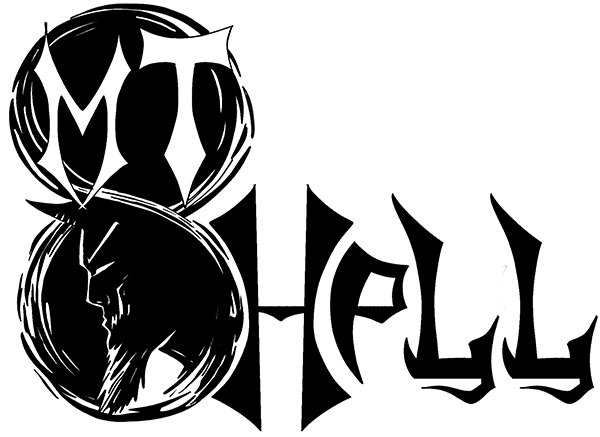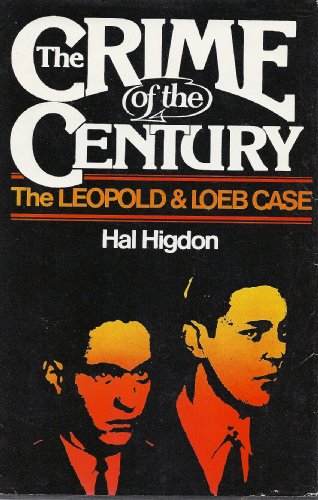
True Crime Studies: Leopold & Loeb and the Crime of the Century
Famous, or rather infamous, for a number of reasons. Nietzsche fanboys spoiled rotten since birth and twisted lovers, they were pretentious little brats that murdered a 14-year-old boy out of sheer boredom. Nathan Leopold Jr. and Richard Loeb, two young Chicago men who introduced the world to “thrill killings.” The ’20s really were a roaring decade.
Leopold & Loeb: The Crime of the Century by Hal Higdon is probably the most informative book you’ll ever find on the topic. Among the thousands of true crime books published since Leopold and Loeb’s reign of fame, a very small percentage are actually about them. The murder of Bobby Franks is extremely well documented as are the court proceedings that followed. Just about every minor detail about the case are easily available to anyone interested with Hidgon’s book being the official textbook on the subject. Leopold & Loeb: The Crime of the Century is a heavily researched, 380-paged true crime document that you’ll come away from feeling like an absolute expert on all things Leopold and Loeb.
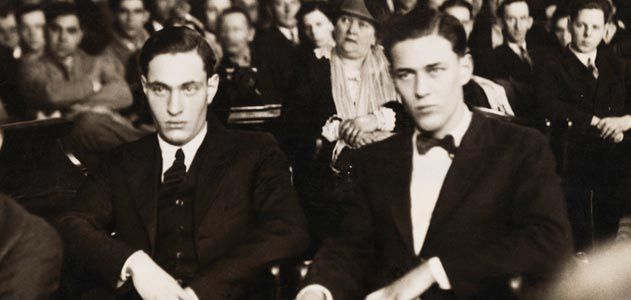
Some true crime books format themselves like novels where the events unfold in an actual narrative, and others are a strictly factual listing of periodic events. This one follows the latter. The bulk of it reads like an extended Wikipedia page where it’s a mixture of actual dialogue and peers/eye-witnesses/investigators recounting everything they know, which is a lot. As I said, both they and their crime are well documented because their one victim was found with relative ease and their confession was offered up on a silver platter. They gave everything up just to brag about it, describing each detail of their ridiculously complicated master plan with excitement burning in their eyes.
Here’s a simplified breakdown:
- Kidnap and kill the chosen victim (Franks was picked at the last minute), must be rich enough to warrant sending the family a ransom note.
- Send ransom note demanding $10,000
- Call family and demand the father, or head of household, to wait for a cab that will drive to a drugstore where further instructions would be waiting.
- Instructions will say to go to the train station where they’re to look in the telegraph box
- Inside would be a note instructing them to board the train and throw the money off the last carriage.
- Leopold and Loeb, watching from afar, would go fetch it later.
The plan might as well have come out of a Perry Mason episode. You just know one of them was masturbating while reading it over in their little bedrooms. The many steps in the plan were on account of them trying to make it clever. Whether or not they got the money was never a concern.
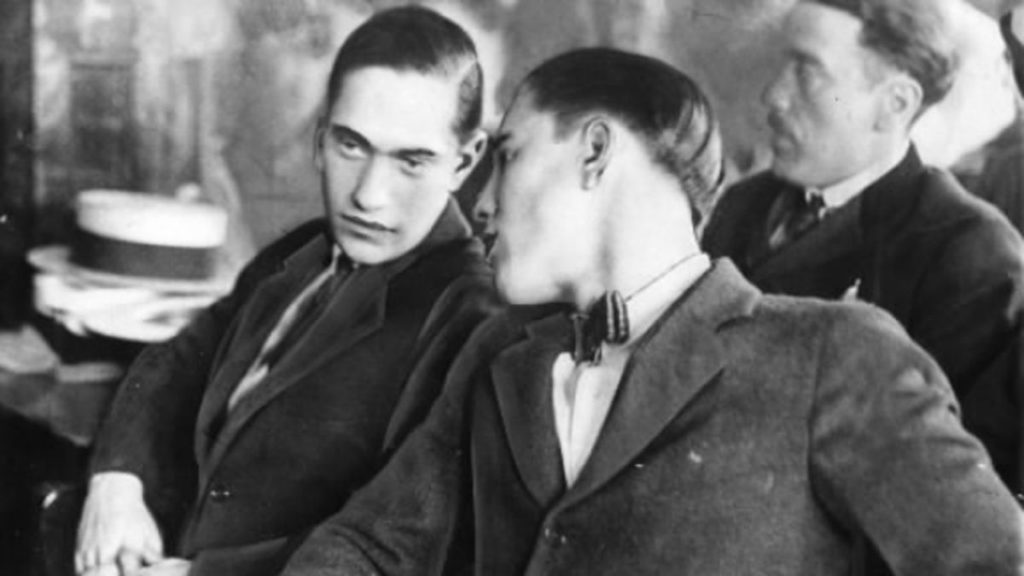
It all starts in 1923, with a robbery at the Zeta Beta Tau fraternity house. Two masked figures familiar with the layout break-in and steal whatever they can fit in their pockets: money, pencils, a pin, a watch, a knife, metals and pens. The only thing they worked at carrying out was an Underwood typewriter. About a year later, that same typewriter would be used to write a ransom note sent to the family of Bobby Franks, after the boy’s body was already dumped in a culvert north of Wolf Lake.
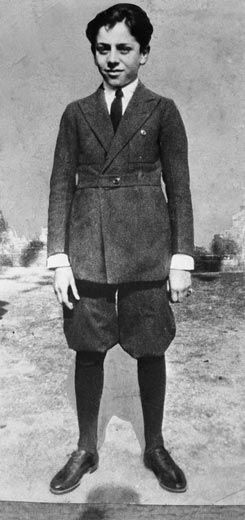
In 1924, Bobby Franks willingly got into a car in broad daylight and was bludgeoned to death. His body was found on May 22, 1924, and the half-assed manhunt began. Bobby had suffered blunt force trauma to the head but apparently died from asphyxiation. Suffocated from either a gag or from being stuffed in the culvert. In an attempt to obscure his identity, hydrochloric acid was poured on his face and genitals to disguise the fact that he had been circumcised, or rather to hide that he was Jewish but all that did was start a rumor of molestation. Many schoolteachers were targeted and accused of pedophilia.
Despite the large gaps in police intelligence, it didn’t take that long for them to track the murder back to Leopold and Loeb. The smoking gun that led police to their door was a pair of bird-watching spectacles Leopold dropped near Wolf Lake and the font and print pattern of the ransom note which matched the stolen typewriter taken from Richard Loeb’s former fraternity house, Zeta Beta Tau. It took about a week to trace the crime back to them.
“We decided to pick the most likely-looking subject that came our way.” Richard Loeb commented in his version: “The plan was broached by Nathan Leopold, who suggested that as a means of having a great deal of excitement, together with getting quite a sum of money.”
Leopold and Loeb
There are three chief reasons why Nathan Leopold and Richard Loeb have lived on in true crime history so prominently and it’s because they were rich young men, their actions were the first time most people ever heard of murder without a proper motive, and they were in a romantic relationship. Though “romantic” is a bit of a stretch. They were in a weird Natural Born Killers type of relationship built off loneliness and co-dependency.
Higdon studies the relationship between them from a distance whilst looking at it from under a microscope. It’s their relationship that makes this story so engaging and it’s also about 50% of the book’s focus.
“Leopold considered himself inferior to Loeb, but Loeb considered himself inferior to Leopold.”
Honestly, every page that features real dialogue between the boys, paired with personal accounts of their behavior, makes them sound like an old married couple. The two openly admitted to planning the other’s death only to immediately change their minds because…who else would they hang out with?
The Crime of the Century points out the gay panic that ruled a lot of young men during that time, murderers included. Upon capture, Loeb was especially reluctant to be labeled a homosexual. He and Leopold were apparently having “sexual liaisons”, as the book calls them, since 1921. But according to Loeb, their “liaisons” were just part of a business agreement where he would offer sex to Leopold in exchange for partnership in crime. Two things contradict this claim: Loeb implied to vague sexual encounters with other men prior to this and their agreement was set up in 1923, two years after their “liaisons” supposedly began.
There was also a whole master/slave fantasy going on, not as sexual as it sounds, between them which would take up too much time to discuss in full so here’s a link to some info on that.
“The alienist felt that the Franks homicide could be understood only by examining the interplay of these two personalities as they related to each other. ‘Dickie needed an audience. In his fantasies, the criminalistic gang was his audience. In reality, Babe [Leopold] was his audience.'”
“Leopold needed Loeb to compliment him and serve his alter ego.”
One can easily say that the murder was a direct result of their relationship. Not only the assumption that they wouldn’t have killed if they never met, but their reason for killing Bobby Franks was directed at one another.
A good film to watch for the Leopold and Loeb relationship is Barbet Schroeder’s Murder by Numbers from 2002. The film goes off track from the actual crime and doesn’t follow any sort of historical accuracy but the relationship between the two boys is more on the mark than in Compulsion, Swoon, and Rope. I can assume that screenwriter Tony Gayton actually read this book before penning Murder by Numbers, only to merge it with a random Sandra Bullock cop drama, which is what ruined it.
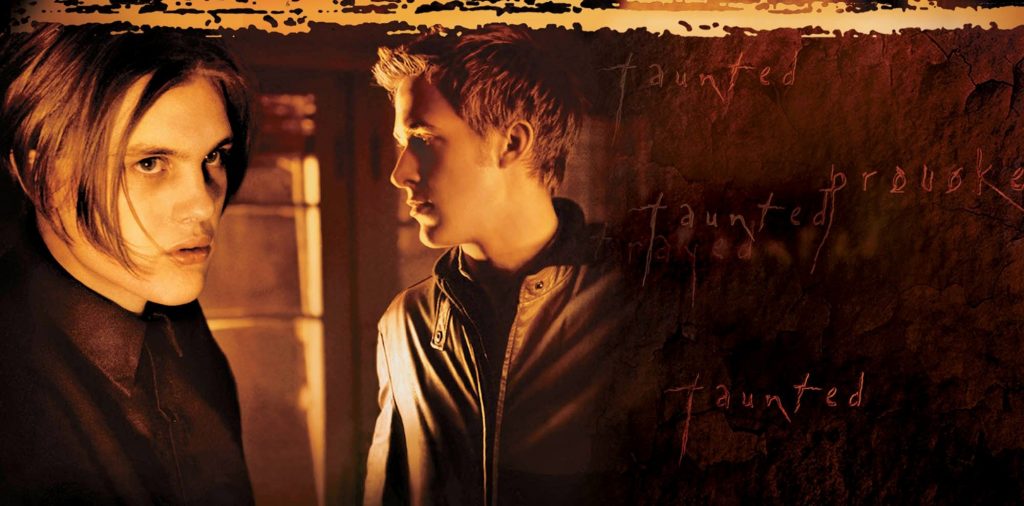
The Hearing
A lot of Leopold & Loeb: The Crime of the Century is dedicated to the hearing. Quick correction, this case is often referred to as the “trial of the century” but it’s not actually a trial because there was no jury, making it a hearing. Leopold and Loeb pleaded guilty so the question of their guilt was already confirmed.
The hearing was about their punishment, whether or not they should get the death penalty. The famed lawyer Clarence Darrow, a fervent opposer of capital punishment, defended them in what would become his most famous case. This part of the book is long, and as someone who hates all things related to court, boring. There are at least two chapters dedicated solely to their psych evaluations, most of which are dated because psychology was still new and many illnesses were incapable of a proper diagnosis.
As I mentioned above, a good film to see Leopold and Loeb’s dynamic is Murder by Numbers, but if you’re interested in the hearing and Darrow, then I recommend Compulsion from 1959. It’s a somewhat accurate portrayal of the hearing and features a good enough replica of Darrow’s famous closing argument.
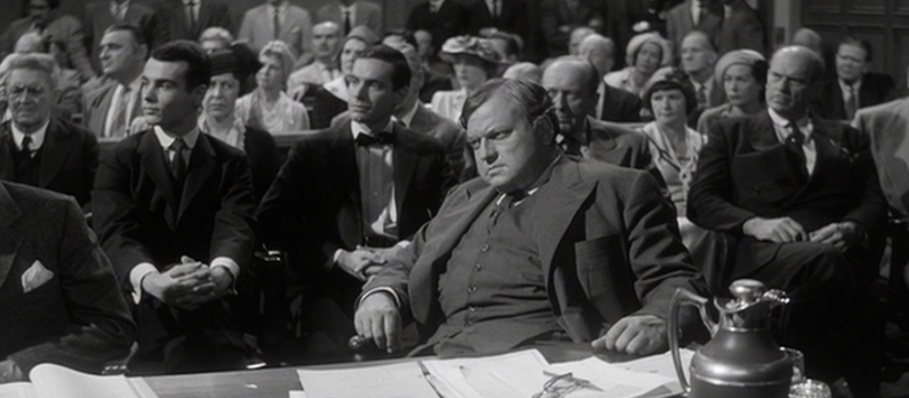
Verdict
There is a lot of information given in this book. You can tell that many years went into the research of it. Unfortunately, it doesn’t off much of anything new but only expands upon on facts that are already widely available. Everything mentioned in The Crime of the Century, I had already heard in some form although the book does develop the case more and fills in some of the blanks.
One of the most interesting sections of The Crime of the Century takes place in Part 3: “Nothing but the Night.” The section is set during their time in prison, they went to the same prison, and shows how incarcerated life has affected them.
 (3.5 / 5)
(3.5 / 5)
Book Reviews
A Stellar Debut Novel, We Used To Live Here
Imagine this. You’re home alone, waiting for your partner to return, when you hear a knock on your door. You answer it to see a family of five, bundled up against the cold. The father, a kindly older gentleman, explains that he used to live in this house as a boy. And he would love to show it to his family.
Do not let them in.
The story
Released in June 2024, We Used To Live Here is author Marcus Kliewer’s debut novel. It tells the story of Eve, who just purchased a beautiful house with her partner, Charlie. Their plan is to flip the house and sell it.
One night, while waiting for Charlie to come home, Eve is surprised by a knock at the door. It’s a man named Thomas Faust and his family.
Thomas explains that he grew up in the house and hasn’t been in the area in years. Would Eve let them in so that he can show the home to his children?
Against her better judgment, Eve lets them in. She regrets this almost at once when Thomas’s daughter vanishes somewhere into the house.
What worked
I always appreciate a book that allows you to play along with the mystery. And this book does that better than just about any other I’ve seen.
Pay close attention to the chapters, to the words that aren’t there. To everything about this novel.
This is mostly down to Kliewer. This is ultimately his work of art. But the production value is also fantastic. I don’t want to ruin the multiple mysteries, so I’ll just say this. There are clues in this book that require some specific artistic choices in the page layouts in this book. And I loved that.
If you’d like to experience another horror book review, check out this one.
We Used To Live Here is also the kind of story that makes you question everything right along with the main character, Eve. Eve is a great main character. But she might be an unreliable narrator. She might be experiencing every single horror described, exactly as it’s described. Or, she might be having a psychotic breakdown. Through most of the book, we can’t be sure. And that is so much fun.
Finally, the weather plays a large part in this story. There are several stories in which the weather or the land itself could be considered a character. Even an antagonist. This is certainly one. The winter storm is the thing that traps the family in the house with Eve. It also makes escaping the home difficult. Reading this book during the winter was especially impactful. Most of us know what it feels like to be shut in by a storm. I’ve personally lived through some of those storms that are just referred to by their year, as though they were impactful enough to claim the whole 365 days for themself. And that was with people I liked. Imagine what it would feel like with strangers. It’s a staggering thought and one that we explore in depth in this book.
- Get Out meets Parasite in this eerily haunting debut and Reddit hit—soon to be a Netflix original movie starring Blake Lively—about two homeowners whose lives are turned upside down when the house’s previous residents unexpectedly visit
- As a young, queer couple who flip houses, Charlie and Eve can’t believe the killer deal they’ve just gotten on an old house in a picturesque neighborhood
- As they’re working in the house one day, there’s a knock on the door
Last update on 2025-03-08 / Affiliate links / Images from Amazon Product Advertising API
In the end, We Used To Live Here is a fantastic book. It’s the sort of story that sneaks into your brain and puts down roots. And if this is just the first book we’re getting from Kliewer, I can’t wait to see what else he comes up with.
 (5 / 5)
(5 / 5)
Book Reviews
Exploring real terror with The House of My Mother
As a disclaimer, this is a review of The House of My Mother from a critical perspective. I will not be discussing my opinions of the legal case against Ruby Franke and Jody Hildebrandt. I will be discussing the merits of the book as a work of true crime alone.
In 2015, Ruby Franke started a YouTube channel called 8 Passengers. In August of 2023, Franke and her business associate Jodi Hildebrandt were arrested for, and later plead guilty to, charges of aggravated child abuse. And in January of this year, Shari Franke told her story in The House of My Mother.
The story
The House of My Mother is the true story of Shari Franke, the oldest child of one of the most famous family vlogger families.
As a child, Shari came to the conclusion that her mother didn’t like her. Soon, she began to fear her mother’s anger.
Things got significantly worse when Ruby started their family vlog. All of the families most intimate moments were splashed across the internet for anyone to watch. This became a living nightmare for Shari.
Of course, that was only the start of the family nightmare. Because Ruby was about to meet someone who would reinforce all of the darkest parts of herself.
Eventually Shari manages to escape her home. But her younger siblings were still in her mother’s clutches. She had to save them, and her father, from the monster her mother had become.
What worked
Through the book, Shari only ever mentions the name of one of her siblings, Chad. This is because Chad is the only of her siblings that is an adult at the time of the publication.
There are children involved in this story. Children who’s lives and privacy have already been damaged. Shari didn’t want to do that to them again, and neither do I.
It probably won’t surprise you that this book is full of upsetting details. But not in the way you might imagine.
Nowhere in this book will you find gory details about the abuse the Franke kids suffered. And I consider that a good thing. Those sort of details are all fun and games when we’re talking fiction. When it’s real kids who are really living with the damage, it’s not a good time.
What you’ll find instead is a slew of more emotionally devastating moments. One that stuck with me is when Ruby’s mother gives her a pair of silk pajamas as a gift after Ruby gave birth to one of her babies. Shari asks Ruby if she’d bring her silk pajamas when she had a baby. Ruby responds that yes, when Shari becomes a mother they can be friends.
What a lovely way to make a little girl feel like she’s not worth anything unless she reproduces. And, if she does decide to have children, who is going to bring her silk pajamas?
- From eldest daughter Shari Franke, the shocking true story behind the viral 8 Passengers family vlog and the hidden abuse she suffered at the hands of her mother, and how, in the face of unimaginable pain, she found freedom and healing
- Shari Franke’s childhood was a constant battle for survival
- Her mother, Ruby Franke, enforced a severe moral code while maintaining a façade of a picture-perfect family for their wildly popular YouTube channel 8 Passengers, which documented the day-to-day life of raising six children for a staggering 2
Last update on 2025-03-02 / Affiliate links / Images from Amazon Product Advertising API
In the end, this isn’t a story about ghosts or demons. It’s not about a serial killer waiting on a playground or in the attic of an unsuspecting family. Instead, this is a story about things that really keep us up at night. It’s the story of a woman so obsessed with perfection that she drove away her eldest daughter. The story of a young woman who’s forced to watch from afar as her beloved brothers and sisters are terrorized and abandoned. These are the sorts of things that really keep us up at night. These are the real nightmares.
More than that, though, The House of My Mother is a story of survival. It’s about a family that was ripped apart and somehow managed to stitch itself back together again. It’s about a brave young woman who managed to keep herself safe and sane in the face of a nightmare. If you haven’t read it yet, I can’t recommend it enough.
For more like this, check out my review of Shiny Happy People.
 (5 / 5)
(5 / 5)
Book Reviews
Book Review of Boreal: an Anthology of Taiga Horror
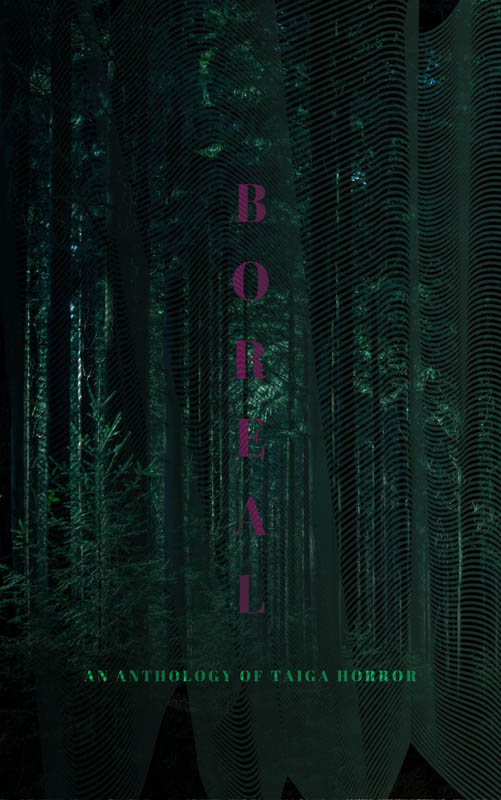
Boreal: an Anthology of Taiga Horror is a collection of twenty-two haunting tales that dwell in the deepest darkest woods and frozen wastelands, edited by Katherine Silva and including Haunted MTL’s very own Daphne Fauber. Each story has even been gifted with its very own poster, hinting at the horrors to be found within it, bestowing a beautiful visual collection as well.
The tales are varied and touch upon the environment in new and different ways, each hearkening to a sort of epiphany or raised awareness. These stories exude both dread and wonder at the smallness of our human existence in contrast to the sacred world we have isolated from, sheltering ourselves in our comfortable houses with centralized heat and everything we could possibly need or want at the ready. The taiga becomes a sanctuary outside of our own dulled awarenesses. It is a holy place imbued with powers beyond mortal human reach, a wilderness that threatens to swallow us – both whole and bit by bit, simultaneously.
The protagonists enter into this realm through ritual, superstition, longing, stubbornness, and their own hubris – yearning to survive its dangers, and to make their own marks upon it. The starkness of their surroundings harbors delicate moments that would be all too easily missed if not deliberately sought or pointed out. The softness of fur, the dappled sunlight shining through trees, the hazy clouds of breath forming in crisp air, the brittleness of bleached bone… those quiet experiences that beg to be forgotten, to lay safely sleeping just below the frozen surface, awaiting spring.
There are those who followed in the footsteps of their predecessors, seeking to escape the constraints of their parent’s and elders’ indoctrination, traditions, madness, and abuse, yearning to find their own way despite also being inextricably bound to their own pasts. There are those who just wanted to go for a walk in the woods, and remained forever changed by what they experienced. There are those who wished to impose their will upon the wilderness, their order falling to disarray, unable to make lasting impact. There are those who sought to leave behind the world of mankind, looking for oneness in the natural order of things through isolation, leaving a bit of themselves behind after being consumed by the terrors they encountered. There are those who truly found communion with the woods, became one with its wildness, and invited its spirit into their hearts to find peace, even at cost of their own lives. And then, there are the spirits themselves…
 (3 / 5)
(3 / 5)
All in all, I give Boreal: an Anthology of Taiga Horror 3.0 Cthulhus. I love existential angst so I found it to be an enjoyable read, and I appreciated the myriad manners in which the biome was explored. But there were points in which I found myself struggling to follow along, as if the words were swept up into their own wilds in ways that alienated myself as reader, as if my mere voyeurism into this otherworldly place was not enough to comprehend the subtle deviations in storytelling mannerisms fully. I suppose in some sense this seems appropriate, but at the same time, it left me feeling a bit unfulfilled, as if I had missed a spiritual connection that should have resonated more deeply.
- English (Publication Language)
- 248 Pages – 02/25/2025 (Publication Date) – Strange Wilds Press (Publisher)
Last update on 2025-01-23 / Affiliate links / Images from Amazon Product Advertising API

